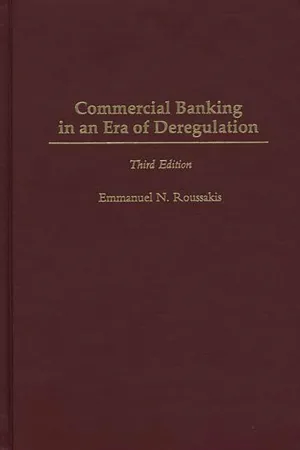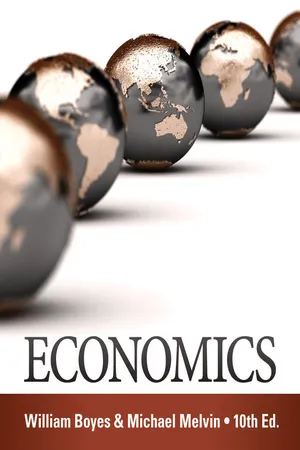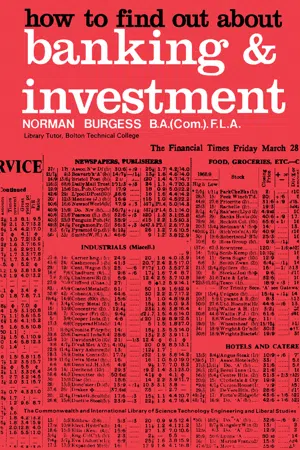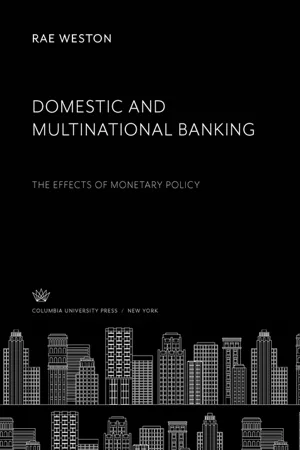Economics
Banking in America
Banking in America refers to the system of financial institutions that provide services such as accepting deposits, making loans, and facilitating payments. It is regulated by various federal and state agencies to ensure stability and protect consumers. The history of banking in America is marked by periods of innovation, regulation, and crisis, shaping the country's economic landscape.
Written by Perlego with AI-assistance
Related key terms
1 of 5
5 Key excerpts on "Banking in America"
- eBook - PDF
- S. Janssen(Author)
- 2009(Publication Date)
- Palgrave Macmillan(Publisher)
It could be conjectured that a clear legal definition of a bank and other financial terms as found in German law could impede the flexibility which appears necessary in the face of the ever faster changes in economic reality. Therefore, the much deplored absence of a clear definition of a bank in the United Kingdom and the tradition of common law (see previous remarks by the Review Committee on Banking Services Law) may have contributed significantly to the faster adaptability of the British authorities. Whichever legal system seems to better adjust to the fast changing economic reality, either tends to react to economic reality, although its reactions may in return have repercussions for that economic reality. Thus, an economic definition What Is a Bank? 15 of a bank should be applicable across borders. The next section outlines the widely accepted microeconomic definition of a bank. 2.6 Microeconomic definition of a bank The preceding sections showed that the varying banking traditions in Britain and Germany prompted different organisational structures in the banking sector. While in the United Kingdom a dual structure with clear- ing banks (DTIs) and merchant banks (NDTIs) prevailed for many years, banks in Germany have traditionally been organised as universal banks. One important issue which emerges from these different organisational forms are the capital adequacy requirements for investment banks and retail banks. The different capital requirements for different types of banks pin- point the most prominent aspect of banking business, namely dealing with risk, which is defined as the deviation from the expected, that is the vari- ance of possible outcomes (Black, 1997, pp. 406–409). Investment banks assist third parties in the management of risk. The bulk of an investment bank’s revenues comprise non-interest income, such as commission fees and trading results, which are not determined by its bal- ance sheet structure. - eBook - PDF
- Emmanuel Roussakis(Author)
- 1997(Publication Date)
- Praeger(Publisher)
Part I Overview of the U.S. Commercial Banking System Chapter 1 Scope of Commercial Banking The U.S. financial system includes a variety of financial institutions, the oldest of which are the commercial banks. The first modern type of bank was chartered in 1781 at Philadelphia, and many of those established in the nineteenth century are still in operation. Perhaps because of this head start, banks have grown to be by far the most important intermediaries. Indeed, with assets in excess of $4 trillion, they constitute the largest type of U.S. financial institution. Banks per- form a variety of functions. Although lending and investing have been the ep- icenter of commercial banking, the last few years have witnessed a general surge in bank services. This surge has reflected the expansion of both the types and the volume of services that banks extend to the communities or markets served. This surge has been induced in part by government regulation, but most im- portantly by competitive pressures. This chapter describes the major functions performed by banks and reviews some salient features of bank financial state- ments. FUNCTIONS OF COMMERCIAL BANKS Commercial banks perform many functions, some central to their main role in the economy and others more peripheral. The three main functions of com- mercial banks are interrelated: the creation of money, accomplished through lending and investing activities; the holding of deposits; and the provision of a mechanism for payments and transfer of funds. They all relate to the banks’ critical role in the overall management of the flow of money and credit through the economy. Other services are offered primarily to draw customers by providing complete money management and ancillary services through a single institution. Some of 4 Commercial Banking these services, such as trust management and leasing, may themselves be prof- itable; others may be loss leaders offered solely to attract depositors to the institution. - eBook - PDF
- William Boyes, Michael Melvin(Authors)
- 2015(Publication Date)
- Cengage Learning EMEA(Publisher)
Banks and the banking system also play key roles, both at home and abroad, in the determination of the amount of money in circulation and the movement of money between nations. After we define money and its functions, we look at the banking system. We begin with banking in the United States, and then discuss international banking. Some-one once joked that banks follow the rule of 3-6-3: They borrow at 3 percent interest, lend at 6 percent interest, and close at 3 p.m. If those days ever existed, clearly they no longer do today. The banking industry in the United States and the rest of the world has under-gone tremendous change in recent years. New technology and government deregulation are allowing banks to respond to changing economic conditions in ways that were unthink-able only a few years ago, and these changes have had dramatic effects on the economy. 12-1 What Is Money? Money is anything that is generally acceptable to sellers in exchange for goods and services. The cash in your wallet can be used to buy groceries or a movie ticket. You simply present your cash to the cashier, who readily accepts it. If you wanted to use your car to buy groceries or a movie ticket, the exchange would be more complicated. You would probably have to sell the car before you could use it to buy other goods and services. Cars are seldom exchanged directly for goods and services (except for other cars). Because cars are not a generally accept-able means of paying for other goods and services, we do not consider them to be money. Money is the most liquid asset. A liquid asset is an asset that can easily be exchanged for goods and services. Cash is a liquid asset; a car is not. How liquid must an asset be before we consider it money? To answer this question, we must first consider the functions of money. 12-1a Functions of Money Money serves four basic functions: It is a medium of exchange , a unit of account , a store of value , and a standard of deferred payment . - eBook - PDF
How to Find Out About Banking and Investment
The Commonwealth and International Library: Libraries and Technical Information Division
- Norman Burgess, G. Chandler(Authors)
- 2016(Publication Date)
- Pergamon(Publisher)
The historical background of present-day institutions of a mone-tary character in the United States is used to clarify present policy in J. G. Ranlett, Money and Banking: an introduction to analysis and policy (New York, Wiley, 1965), which the author suggests is a text for an undergraduate course in money and banking. The interaction of the Federal Reserve System and the commercial banks is considered and there is reference to international monetary policies. These books and W. Welfing, Money and Banking, new edn. (New York, American Bankers Association, 1965), remind the British reader of the main differences between English and American banking practice. In America there are some 14,000 banks, the majority of which have little interest in foreign trade. The Association textbook confirms this with its sparse references to this aspect of banking, although there is a good sketch of the commercial background and of the Federal Reserve System. C. L. Harriss, in his Money and Banking, 2nd edn. (Boston, Allyn & Bacon, 1965), assumes only elementary knowledge of economics and an instructor's manual is available. In addi-tion, the same publisher's Self-Correcting Problems in Money, Banking and Monetary Theory by M. E. Deprano (1966) is a FINANCIAL ECONOMICS 53 useful supplementary text. This paperbound volume is one of a series of texts based on the observation that many prob-lems in business and economics may be classified by compu-tations; it covers calculations involved in monetary trans-actions, balance sheets, etc. The practical side of banking and the relationship of banks to business is stressed in Money and Banking, 4th edn. (Engle-wood Cliffs, Ν J, Prentice-Hall, 1953), written by M. R. Foster and others and for which an instructor's manual is published. In addition to a survey of banking history and the theory and practice of Banking in America there is information on the banking systems of Britain, France, Canada, and the Nether-lands. - eBook - PDF
Domestic and Multinational Banking
The Effects of Monetary Policy
- Rae Weston(Author)
- 2019(Publication Date)
- Columbia University Press(Publisher)
Further Reading Giuseppi, John, The Bank of England: A History from Its Foundations in 1694 The Nature of Banking 23 (Evans Bros, London, 1966) Nevin, Edward and E.W. Davis, The London Clearing Bank* (Elek Books, London, 1970) THE ESSENCE OF BANKING 'It is the conglomeration of all the various services and functions that sets the commercial bank off from other financial institutions. Each then is an integral part of the whole, almost every one of which is dependent upon and would not exist but for the other.' (J. Clary in US. v. The Philadelphia National Bank and Girard Trust Com Exchange, 201 F.Supp. 348 (1962) 363.) The many analyses of banking at a microeconomic level that concen-trate on the allocation of a bank's funds between competing stocks of assets, regard a bank not as a firm but as a rational investor operating in an environment of uncertainty or as Klein 1 puts the point 'the neo-classical analysis of the firm has yielded to portfolio theory' (p.205). Unfortunately this view appears to do much less than justice to the art of banking. The comment of the celebrated European banker, the late Louis Camu, 2 that 'current usage tends to confuse the image of the banker with that of the financier' appears a quite appropriate descrip-tion of the debate about banks as firms or investors (p.67). Camu's definition of the financier accords with that of the rational investor who manages a portfolio of mainly financial assets and may be contrasted with his definition of the banker who is 'primarily a large retailer'. While the essence of the rational investor's activities are those of the portfolio manager who seeks to restrict the range of activities on which there is risk so that the maximum return consistent with the preferred level of risk is obtained, the essence of banking is rather that of the firm which has potential customers of many sizes, all of whom it wishes to serve.
Index pages curate the most relevant extracts from our library of academic textbooks. They’ve been created using an in-house natural language model (NLM), each adding context and meaning to key research topics.




